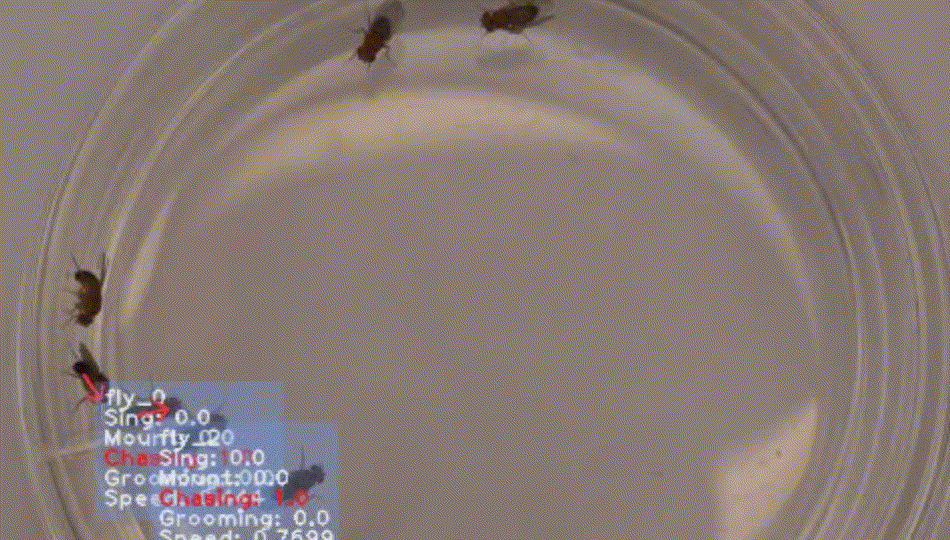What is the easiest way to know if a fruit fly is hungry? Ask a computer.
 The MAFDA system can track individual flies within a larger group, identify behaviors, and compare those behaviors with fruit flies’ genotypes. Image Credit: Tulane University
The MAFDA system can track individual flies within a larger group, identify behaviors, and compare those behaviors with fruit flies’ genotypes. Image Credit: Tulane University
While that may sound like a bad dad joke, it is an actuality at Tulane University, where investigators have produced a new AI tool that can tell whether a fruit fly is hungry, sleepy, or singing (yes, fruit flies sing).
The MAFDA (for Novel Machine-learning-based Automatic Fly-behavioral Detection and Annotation) system tracks and identifies complex interactive behaviors of individual flies within a larger group using cameras and newly developed software. This enables scientists to compare and contrast the behaviors of fruit flies from various genetic backgrounds.
For more than a century, researchers have used fruit flies’ simple genome and short lifespan to decode mysteries of inheritance and immunity in humans with studies of Drosophila melanogaster, earning six Nobel Prizes. Fruit flies are a commonly used model organism as they are 60% of their DNA with humans.
Earlier algorithms were less precise at analyzing individual flies within a group, but the MAFDA system simplifies research on the tiny, winged insects.
Fruit flies are like pioneers in the discovery of new things, from innate immunity to the chromosome theory of inheritance. To be able to quantify the flies’ behavior is really a step forward in behavior studies.”
Wu-Min Deng, Study Corresponding Author and Professor, Biochemistry and Molecular Biology, Tulane School of Medicine, Tulane University
Wu-Min Deng is also the Gerald & Flora Jo Mansfield Piltz Endowed Professor in Cancer Research at Tulane School of Medicine.
Wenkan Liu, a School of Medicine Graduate Student who created the MAFDA system, stated that the platform’s importance is “undeniable.”
It speeds up research, minimizes human error, and provides intricate insights into behavior genetics. This tool is potentially pivotal as it enhances reproducibility and paves the way for new explorations in large-scale behavioral analysis.”
Wenkan Liu, Tulane School of Medicine, Tulane University
MAFDA was created as part of recent research that revealed that the gene that provokes flies to perceive pheromones, chemical substances generated by other fruit flies that are important for attraction and other processes, is also the gene that controls pheromone production.
The findings, published in Science Advances, negate the conventional thinking that pheromone production and perception are controlled by separate genes. The findings have wide-ranging implications for human behavioral evolution, metabolism, and sex dimorphism.
The team hopes to see MAFDA used in a variety of applications in the future. According to Jie Sun, Lead Author and Postdoctoral Fellow at Tulane School of Medicine, MAFDA can be used to investigate other insects, mice and fish in the future, and the system could be helpful in understanding drug effects in humans.
The more information we give the machine, the better it gets at correctly identifying different behaviors from courtship to feeding and so on. This is a very important, meaningful tool.”
Jie Sun, Study Lead Author and Postdoctoral Fellow, Tulane School of Medicine, Tulane University
MAFDA is already being used on other Tulane research projects, and scientists have been working to package the system so that it can be used by more researchers at Tulane and around the world.
Deng concludes, “That’s the goal. The original idea was to be able to identify the health status of flies. That may be too much to ask right now, but we’re hoping this will be more broadly used by the community and hopefully in the future we can go in that direction.”
Source:
Journal reference:
Sun, J., et al. (2023). Integrating lipid metabolism, pheromone production and perception by Fruitless and Hepatocyte Nuclear Factor. Science Advances. doi.org/10.1126/sciadv.adf6254.